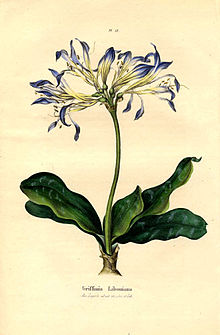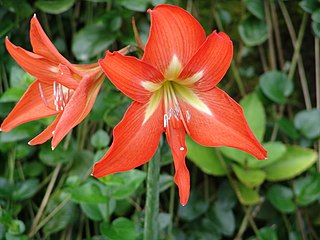
Hippeastrum is a genus of about 90 species and over 600 hybrids and cultivars of perennial herbaceous bulbous plants. They generally have large fleshy bulbs and tall broad leaves, generally evergreen, and large red or purple flowers.

Sprekelia is a genus of Mesoamerican plants in the Amaryllis family, subfamily Amaryllidoideae. Sprekelia plants are sometimes called Aztec lilies or Jacobean lilies although they are not true lilies. This genus has been submerged in Zephyranthes, but as of January 2023 is accepted by Plants of the World Online with a single species, Sprekelia formosissima, endemic to Mexico.

Eucrosia is a genus of herbaceous, perennial and bulbous plants in the Amaryllis family distributed from Ecuador to Peru. The name is derived from the Greek eu, beautiful, and krossos, a fringe, referring to the long stamens. As circumscribed in 2020, the genus contains six species. Phaedranassa and Rauhia are the genera most closely related to Eucrosia.
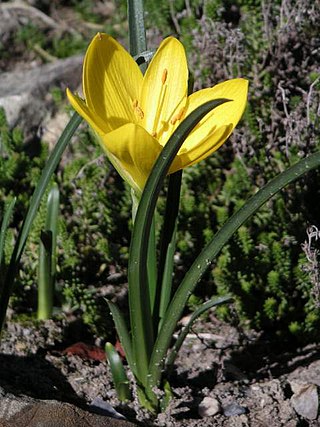
Sternbergia is a genus of Eurasian and North African plants in the Amaryllis family, subfamily Amaryllidoideae.

Rhodophiala was a genus of herbaceous, perennial and bulbous plants in the Amaryllis family. It consisted of about 30 South American species distributed in southern Brazil, Argentina, and, specially, in Chile. Most of the species are known colloquially as añañuca. It has now been submerged in Zephyranthes.
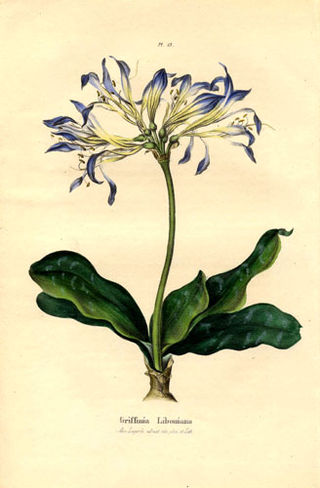
The tribe Griffineae includes 2 genera with 22 species from South America which are actually endemic to Brazil. A typical character of the representatives of the tribe are the flowers - They are with blue or lilac color collected into an umbel. Only the members of this tribe and the genus Lycoris are able to form flowers with such color in the whole family Amaryllidaceae. The plants in this group are typical perennial flowers which are producing bulbs. The leaves are green, with elliptical form in the most of the cases but in some members as in Worsleya they are sword-shaped.
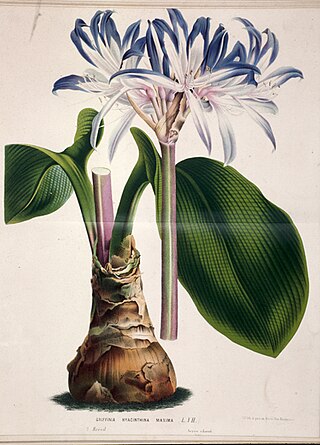
Griffinia hyacinthina is a bulbous species of flowering plant which is endemic to Brazil.
Alan W. Meerow is an American botanist, born in New York City in 1952. He specializes in the taxonomy of the family Amaryllidaceae and the horticulture of palms and tropical ornamental plants. He also works on the population genetics and molecular systematics of cycads and palms.

The Amaryllidaceae are a family of herbaceous, mainly perennial and bulbous flowering plants in the monocot order Asparagales. The family takes its name from the genus Amaryllis and is commonly known as the amaryllis family. The leaves are usually linear, and the flowers are usually bisexual and symmetrical, arranged in umbels on the stem. The petals and sepals are undifferentiated as tepals, which may be fused at the base into a floral tube. Some also display a corona. Allyl sulfide compounds produce the characteristic odour of the onion subfamily (Allioideae).
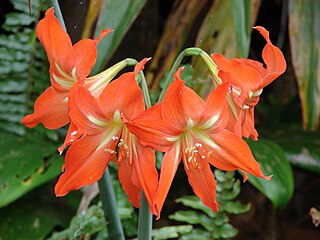
Hippeastreae is a tribe of plants belonging to the subfamily Amaryllidoideae of the Amaryllis family (Amaryllidaceae). Species in this tribe are distributed in South America. Flowers are large and showy, zygomorphic, with the stamens in varying lengths, inflorescence bracts are often fused basally. The seeds are flattened, winged or D-shaped. Reported basic chromosome numbers are x= 8-13, 17, and higher. All the species in this tribe present a remarkable aesthetic interest and horticultural value.

Stenomesson is a genus of bulbous plants in the family Amaryllidaceae. All the species are native to western South America.

Amaryllidoideae is a subfamily of monocot flowering plants in the family Amaryllidaceae, order Asparagales. The most recent APG classification, APG III, takes a broad view of the Amaryllidaceae, which then has three subfamilies, one of which is Amaryllidoideae, and the others are Allioideae and Agapanthoideae. The subfamily consists of about seventy genera, with over eight hundred species, and a worldwide distribution.

Hippeastrinae is a subtribe of plants classified under the tribe Hippeastreae. It belongs to the subfamily Amaryllidoideae of the Amaryllis family (Amaryllidaceae).

Hippeastrum calyptratum is a flowering perennial herbaceous bulbous plant, in the family Amaryllidaceae, native to Brazil.

Phycella is a genus of herbaceous, perennial bulbous flowering plants belonging to the family Amaryllidaceae, subfamily Amaryllidoideae. The genus consists of five species distributed from central Chile to northwestern Argentina.

Traubiinae is a subtribe of plants classified under the tribe Hippeastreae. It belongs to the subfamily Amaryllidoideae of the Amaryllis family (Amaryllidaceae).

Eucharideae is a tribe of plants within the family Amaryllidaceae. It was augmented in 2000 by Meerow et al. following a molecular phylogenetic study that revealed that many elements of the tribe Stenomesseae segregated with it, rather than separately, and were subsequently submerged in it. Further revisions were made in 2020, when three genera were merged. It forms one of the tribes of the Andean subclade of the American clade of the subfamily.
